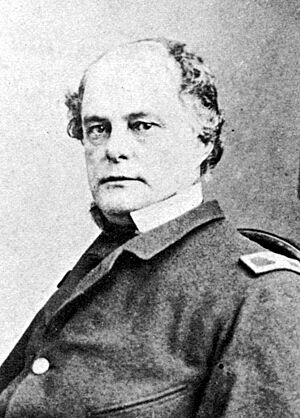North Pacific Exploring and Surveying Expedition facts for kids
The North Pacific Exploring and Surveying Expedition, also known as the Rodgers-Ringgold Expedition, was a big scientific and exploration project by the United States. It happened from 1853 to 1856.
Commander Cadwalader Ringgold (born 1802, died 1867) was the first leader of this journey. But he was later replaced in Hong Kong. A group led by Commodore Matthew Perry made this decision. After that, Lieutenant John Rodgers (born 1812, died 1882) took over. He led the expedition until it finished.
Contents
Starting the Journey with Commander Ringgold
Commander Ringgold sailed on a ship called USS Porpoise. He had actually commanded this ship before, during another big exploration trip years earlier.
Other ships joined the expedition too. These included the USS John Hancock, which was led by Lieutenant John Rodgers. There were also three other vessels, like the USS Vincennes.
The Porpoise joined the other ships at Hampton Roads. They all set sail together on June 11, 1853. They made stops in places like Funchal in the Madeira Islands, and Simonstown in False Bay. The expedition then reached Batavia (which is now Jakarta) in Java on December 12. They arrived in China in March 1854.
Exploring Asian Waters
The expedition spent five months exploring the waters around the large islands near Southeast Asia. In early May 1854, the John Hancock, with Rodgers in charge, sailed to Hong Kong. It arrived there on May 24.
The ships used Hong Kong as their main base for the whole summer. From there, they explored nearby coasts, islands, and rivers. At this time, China was facing problems with rebellions and pirates. These issues put foreigners and their belongings in danger. The American ships helped protect American citizens and their interests.
During one trip up the Canton River, two armed boats from the John Hancock were shot at by rebel cannons. But the Hancock's own cannons quickly fired back and silenced the rebels.
New Leadership and Continued Exploration
In July 1854, Commander Ringgold became ill. Some reports say he had malaria and was sent home. However, another book, "Sea of Glory" by Nathaniel Philbrick, says that Ringgold started acting strangely once they were in China. He kept his ships in port, always repairing them.
Commodore Perry, who was on his own expedition, arrived and called an official meeting. This group decided to remove Ringgold from command of the expedition and send him home. Perry reportedly said Ringgold was "insane." John Rodgers was then given full command of the expedition. He successfully finished the mission.
The ships then sailed north along the coast, going all the way to the Bering Sea. They continued to survey and map the areas as they went.
The expedition also explored islands far from the Asian coast. These included the Bonins, the Ladrones, and the Marianas. Sadly, the Porpoise separated from the other ships on September 21, 1854, between Formosa and China. It was never seen again. People believe it sank in a powerful typhoon that happened a few days after it left the group.
Journey to North America and Key Discoveries
After exploring the Bering Sea, the expedition turned south. They sailed along the western coast of North America. In March 1856, the expedition arrived at Puget Sound. Here, they helped to stop Native American uprisings. These uprisings were threatening to destroy the white settlements and army outposts that had been built in the early 1850s.
What the Expedition Achieved
This expedition did many important things. It greatly increased what people knew about the western and northern Pacific Ocean. It also helped to boost trade and made sailing much easier in areas that were not well known before.
The expedition is also recognized for helping to build friendly relationships between the United States and several countries in East Asia.




